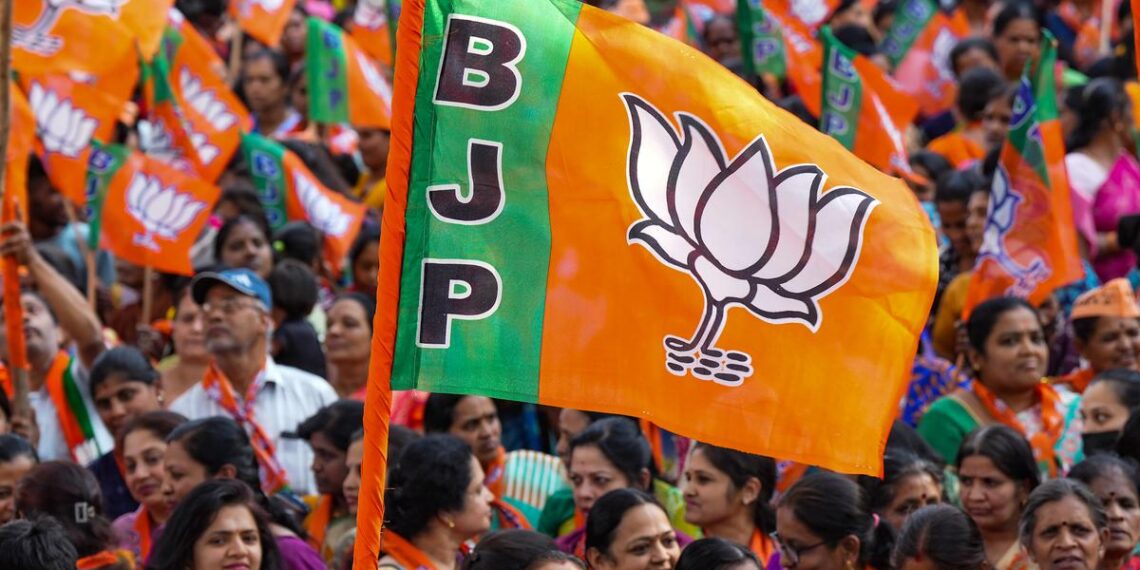SWAMI DIVYA GYAN

Ranchi, Oct 9: The Bharatiya Janata Party (BJP) secured a historic third term in the Haryana Assembly elections, defying expectations of anti-incumbency and widespread predictions of a resurgent Congress. This victory was no accident—it was the result of calculated political strategy, deep grassroots engagement, and effective management of the caste and regional dynamics that define Haryana’s electorate.
Exploiting caste dynamics: A strategic masterstroke
Haryana’s political landscape has long been shaped by the Jat community, a group that has traditionally wielded substantial power in the state. However, the BJP capitalized on the underlying resentment among non-Jat communities, which make up about 75% of the population. In a state where caste identities hold immense electoral importance, the BJP effectively consolidated support from non-Jat groups such as Punjabis, Brahmins, OBCs, and Rajputs. This shift away from the traditional Jat-dominated power structure allowed the BJP to position itself as a party of inclusivity, appealing to those who felt marginalized under previous governments that focused heavily on Jat interests.
The BJP’s decision to avoid presenting a Jat leader as its chief ministerial candidate was a deliberate strategy to build a broader electoral coalition. By rallying non-Jat communities against the traditional dominance of Jats, the party successfully neutralized the Congress’s reliance on Jat-centric politics.
Leadership change: Addressing anti-incumbency through fresh faces
One of BJP’s most effective moves was the replacement of the sitting Chief Minister, Manohar Lal Khattar, with Nayab Singh Saini, a leader from the OBC community. After serving two terms, Khattar faced significant anti-incumbency, with accusations of being disconnected from grassroots concerns. By introducing Saini as the new face of the party, the BJP addressed the rising dissatisfaction with Khattar’s administration and provided fresh energy to its campaign. This move also broadened the party’s appeal to the OBC electorate, a significant voting bloc in Haryana.
This leadership change underscored the BJP’s ability to adapt to evolving political conditions and showcased the party’s strategic foresight. By selecting a candidate from the OBC community, the BJP both alleviated internal discontent and expanded its influence in critical constituencies.
Also Read- Politics of Jharkhand: Hemant Soren vs BJP
Congress’s strategic missteps: Overconfidence and Jat-centric focus
The Congress entered the Haryana elections with high expectations, buoyed by their strong performance in the Lok Sabha elections. However, internal divisions and strategic overconfidence proved to be their undoing. Led by Bhupender Singh Hooda, the Congress’s campaign was overly reliant on Jat support, alienating non-Jat communities who felt ignored by the party’s narrow focus. This was a critical miscalculation in a state where caste-based polarization can significantly influence electoral outcomes.
Additionally, the Congress failed to present a united front, with internal rifts between senior leaders disrupting the party’s coherence. This lack of unity contrasted sharply with the BJP’s disciplined and cohesive campaign, making it difficult for the Congress to challenge the BJP’s well-organized efforts.
The Congress’s overconfidence, combined with an exclusionary focus on Jat voters, further narrowed its appeal.
Fragmentation of Opposition: A disunited front
Another crucial factor in the BJP’s victory was the fragmentation of opposition votes. Smaller regional parties like the Jannayak Janata Party (JJP) and Indian National Lok Dal (INLD) siphoned off votes that could have consolidated against the BJP. The division of opposition votes prevented any single party from mounting a significant challenge to the BJP’s dominance. The regional parties’ inability to unite under a common cause against the ruling party left the anti-BJP sentiment scattered and ineffective.
This disunity among opposition parties played directly into the BJP’s hands, as the fragmented opposition diluted the anti-incumbency vote. Had the opposition presented a united front, the electoral dynamics might have shifted, but the lack of coordination allowed the BJP to maintain a decisive edge in critical constituencies.
RSS’s role in grassroots mobilization: The hidden engine
While the BJP’s visible campaign machinery was well-oiled, the real strength lay in the covert but highly effective involvement of the Rashtriya Swayamsevak Sangh (RSS). The RSS, through its 56 affiliated organizations known as Vividh Sangathan, played a critical role in the BJP’s grassroots mobilization efforts. Volunteers from these organizations organized small, localized meetings at the community level, engaging directly with voters in mohallas and bastis across Haryana.
This covert network of RSS-affiliated organizations worked behind the scenes to build personal connections with voters, addressing their local concerns and rallying them in favor of BJP. The intimate, ground-level outreach orchestrated by the RSS gave BJP an unparalleled advantage in rural and semi-urban constituencies, where personal connections often hold more sway than large-scale political rallies. The RSS’s involvement ensured that BJP’s message resonated deeply with voters across different social strata, creating a solid foundation of support.
Effective grassroots campaigning: Reaching the unreachable
The BJP’s grassroots campaign was not only organized but deeply integrated into the social fabric of Haryana’s communities. The combination of local outreach and engagement, supported by the RSS and its affiliated organizations, ensured that the BJP’s message penetrated even the most remote areas. The party’s ability to engage with voters on a personal level, addressing their specific concerns and needs, created a sense of trust and loyalty that transcended traditional political affiliations.
This grassroots strategy was complemented by a robust communication network, where BJP utilized local influencers, community leaders, and social organizations to amplify its reach. The effectiveness of this campaign was seen in the BJP’s strong performance across rural and semi-urban areas, where voter loyalty is often shaped by direct engagement rather than media-driven narratives.
Conclusion: A masterclass in political strategy
The BJP’s victory in Haryana is a case study in how careful, calculated strategies can overcome anti-incumbency and electoral challenges. By exploiting caste dynamics, making astute leadership changes, and leveraging the grassroots influence of the RSS, the BJP demonstrated its ability to adapt to shifting political landscapes and execute strategies with precision. The Congress’s overconfidence and mismanagement of caste politics, combined with a fragmented opposition, further cleared the path for the BJP’s success.
As Haryana enters a new phase under the BJP’s leadership, the lessons from this election offer a roadmap for future political campaigns. The BJP’s victory in Haryana showcases how a well-orchestrated campaign, backed by grassroots mobilization and strategic foresight, can overcome even the most formidable electoral obstacles. This win will likely serve as a blueprint for the BJP’s approach in other states, reinforcing the party’s dominance on the national stage.


